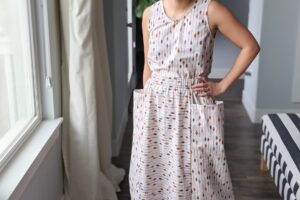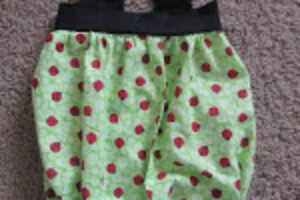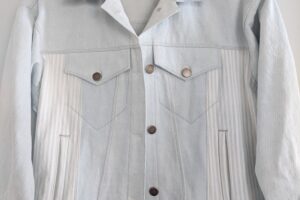
Sewing was not something I grew up doing. I learned the basics in middle school but didn’t think about it again when the unit ended. In my mind, sewing was quilting or making small adjustments. It was a skill one could use for practical purposes. It wouldn’t occur to me for years after I got my first sewing machine that it could be so much more.
For a short list of affordable, entry-level machine recommendations, check out this post.
*This post contains affiliate links. If you purchase through a link, I may receive a small commission at no extra cost to you.
My First Machine: Brother XL2600i

I got my first sewing machine as a holiday gift in 2010. It was a well-rated entry-level machine my husband picked out after I told him I was interested in learning to sew. We’d recently made our first DIY Halloween costume for our oldest using a glue gun to piece it all together and I thought a sewing machine could be useful for future costumes, possibly clothing, and other things.
This first machine didn’t have a lot of features, but it helped me make my first clothing item, a bubble dress for my youngest, and other things for a few more years. I didn’t know much about sewing so I looked for free online tutorials and learned what I needed to know as I worked through them.
My Second Machine (the one I made my clothes with): Brother CS6000i

A few years into sewing, I got a new machine from my husband for Mother’s Day. He saw that I liked to sew, even though I didn’t realize how good it was for me, and thought it was time for an upgrade. I didn’t expect the gift so I was initially upset with him. I thought my old one was fine and that he was wasting money with an upgrade. Turns out he was right and this would be the machine I’d advance my skills on the most. (He is the catalyst for most of my machines.)
Switching to this machine drastically changed things for me. Most of the frustrations I had with my previous machine went away and I realized my skills weren’t lacking as much as I thought. The problems I could never figure out before were due to the machine, not my own error. It was so gratifying to realize that.
This is the sewing machine I made all of my handmade wardrobe on and the one I always recommend to beginners. It is slightly more than some machines, but the headaches you avoid are worth it. It also comes with all the sewing feet you could want making this the best bang for your buck.
If you have this machine and wonder why I upgraded, I did so because I wanted to, not because I needed to. With this machine, I’ve made everything from costumes to clothing to bags. I got it in 2014 and steadily used it from 2018 to 2023. It’s handled everything I’ve put through it and I would keep using it if I hadn’t decided to upgrade.
My Serger: Brother 1034D

In 2016, my husband once again gifted me with another machine. This time, a serger (AKA overlocker) which became a game changer once I got up the courage to learn how it worked. This is another machine I got so mad at my husband for getting me because I was so intimidated by it and didn’t think I deserved it. (I tend to give myself a guilt trip when I get nice things. I’m working on that.)
It sat in the box for a while before I opened it. Once I pulled everything out, I was immediately overwhelmed and put it away. I can’t remember how long it took me to finally use it, but I regretted waiting so long after I did. There was a slight learning curve, but I was able to find a YouTube tutorial for everything I needed help with.
The most asked question I get about sergers is whether or not it is needed to make your own clothes. The answer is no. You don’t need a serger to make your own clothes, but it can be a game changer in leveling up your sewing skills. It has been worth it to me to get a professional finish and has also made sewing knits significantly easier.
My Coverstitch: Brother Coverstitch 2340CV

After sewing mostly woven clothing for years, I wanted to delve more into knits. I realized that I didn’t love my knit garments, because I didn’t like the finishes I could do with my regular sewing machine.
I mentioned to my husband that I was interested in a coverstitch at some point and he, of course, took it upon himself to research and gift me one for the holidays. He purchased a two-in-one, serger and coverstitch, which he didn’t realize was usually not well-reviewed so we exchanged it for the Brother.
If you’re familiar with Brother machines, you’ll find similar features with this one like a color-coded threading guide which I appreciate. The learning curve on the coverstitch was surprisingly low and I was able to get it threaded and sewing pretty quickly right out of the box.
If you know how to use a serger, then a coverstitch is going to be very easy for you to learn. Threading on the coverstitch is a lot more straightforward than a serger too.
After having the coverstitch since the end of 2020, I have to say that it’s the least used machine in my collection. I don’t make a lot of knits though I love the finish I get whenever I do. It’s a toss up whether or not I would recommend past me to get this machine. I like that I have it, but it’s definitely a splurge.
My New Machine: Brother Pacesetter PS700

I decided to upgrade my sewing machine after almost 9 years with my previous machine because I felt it was time. I had the energy to try something new and thought I’d learn more quilting.
My previous machines were purchased online based on reviews, but the next machine to get wasn’t obvious to me so we went to a sewing machine store I had a great experience with the sales associate who answered every question I could think of and my husband helped me pick one out as a birthday gift.
Notable things I learned at the sewing machine store:
- The biggest difference between my under $200 machine and the ones in the store (all starting at least twice that): metal components. Inexpensive machines are made with a mix of plastic and metal while the pricier machines contain only metal components.
- Bernina machines are each made by a single person.
The machine I chose was another Brother. I stuck with Brother because it was affordable and didn’t require a learning curve. I was intrigued by the other brands at the shop, but I would’ve had to sacrifice a lot of features or pay a lot more, which didn’t seem worth it.
After using the Brother PS700 for a few projects, I was impressed by how smooth and quiet it was. I loved the thread-cutting feature, but also quickly realized it wasn’t going to automatically make me a better sewist. I don’t know what my expectations were, but I still dealt with wonky lines and uneven stitches if I wasn’t paying attention.
Now that I’ve used it for many months and for several different projects, I’ve found myself not using any of the features that initially sold me on it. I stopped using the thread-cutting feature, especially with clothes because it makes the first backstitch on a new line very messy. I don’t use the knee thing. I don’t use the extended table. Basically, I don’t use any of the features that quilters must love it for, because I haven’t really started quilting like I thought I would.
What I still like about the machine is how smooth and easy it is to work with. I didn’t realize how loud and clunky my previous machine was until I started using this one. I like the automatic needle threader, which stopped working well on my last machine. The biggest difference I like best between my old machine and this one is the larger workspace. The throat space on my machine looks tiny compared to the new one and I like that I don’t have to wrestle fabric through as much anymore.
Is it worth the cost difference from my previous machine? At first, I thought time would tell, but then I took many months later to finish writing this post and have used the machine for over a year now. Logically, there’s no way it can be worth 5x the cost of my previous machine, especially since I haven’t been sewing as much. If I were sewing a lot more (like in 2018 at the beginning of my handmade wardrobe) or sewing more quilts, I could justify the cost.
At this point, I view it as a splurge rather than a necessity, but would recommend it to anyone who has a higher budget and wants a machine that can stick with them through their sewing journey.
Machine Timeline:
- 2010: Brother XL2600I
- 2014: Brother CS6000i (Current model)
- 2016: Brother 1034D Serger
- 2020: Brother 2340CV Coverstitch
- 2023: Brother Pacesetter PS700
When did you get your first sewing machine? How did you choose a new machine?
Thanks for reading!





Leave a Reply
Your email is safe with us.